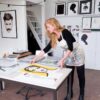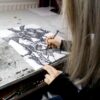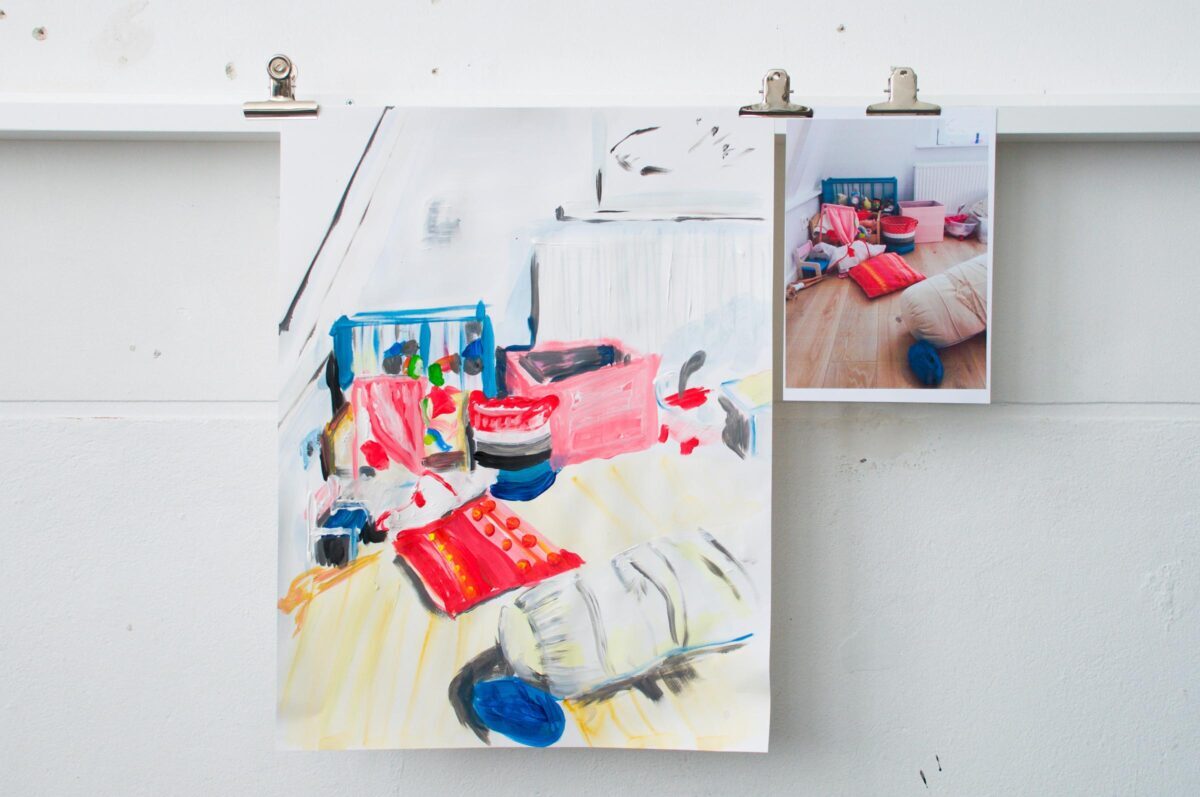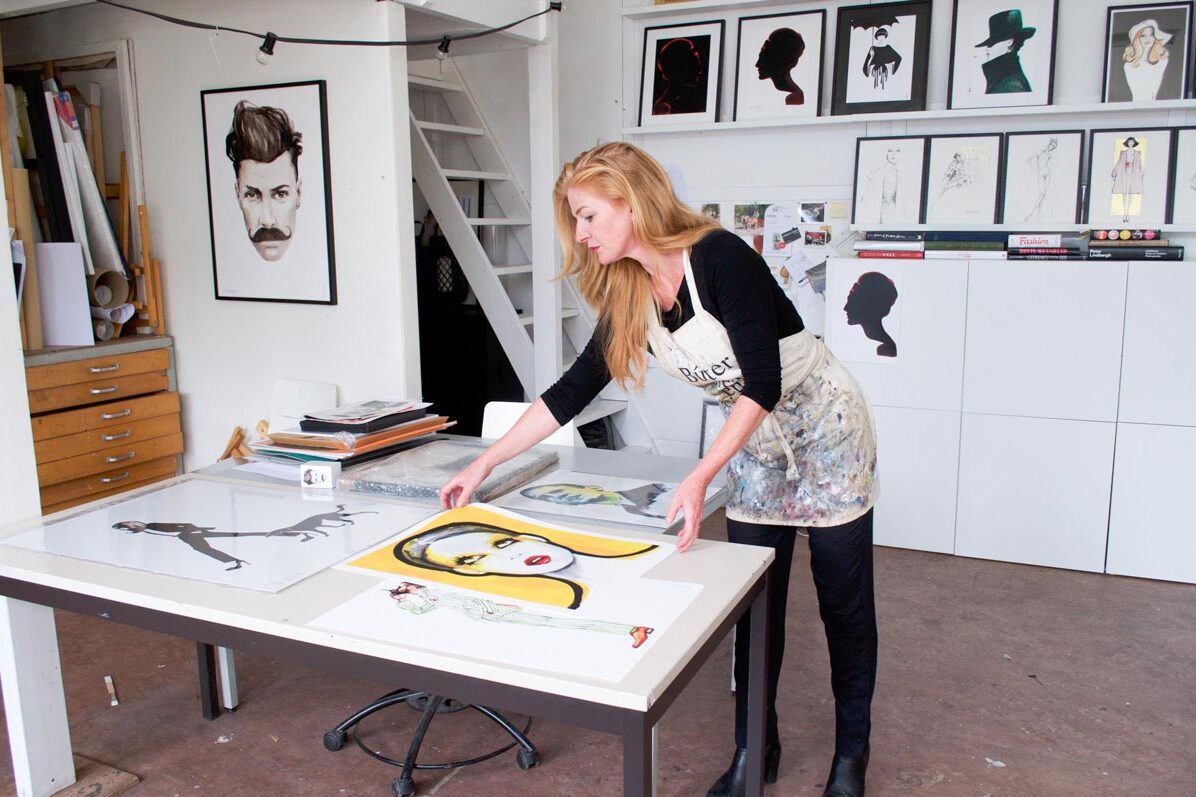Former club owner Nadine Spronk is a creative entrepreneur, artist and poet who works on canvas, paper, fabric and silk. She also runs her own artist label of hand-painted garments and silk scarfs “De Nieuwe Couture”. Her studio is at cultural hotspot ACTA in Amsterdam West.
How did it all start?
For the past 8 years, I was running different clubs in Amsterdam. I was one of the founders of Radion. It was amazing to be surrounded by all these people and to organise the most exciting nights for them… Always trying out new concepts and transforming clubbing into a dynamic playground for people. But it was also loads of work: organising, building, decorating and such. At a certain point, I decided that I had enough and that I wanted to work as an artist again.
The first 8 months I locked myself in my studio to just work and produce things. I wanted to find who I really was. There were certain rules in my life that I had to get rid of and I needed to define my own rules instead. Tilting everything and loosening things up helped me. It was one big discovery!
What materials do you use?
I paint on different kinds of material: canvas, paper, fabric and silk. I used to work with oil paint but it takes too long to dry. That is why I switched to acrylics and I use oil on top in order to add dimension and depth. For my scarfs, I use special silk paint or acrylics mixed with water.
How much time do you spend in your studio?
3 to 4 days a week I take care of my son. The rest of the days I can’t wait to get into the studio. Then I just work day and night as if time doesn’t exist. Being a part-time mum is a good balance for me. If I would have too much freedom and time I wouldn’t be as productive.
Can you describe your process?
I usually work on several canvasses at the same time. Dividing my focus between different projects feels more calm. And there is always some painted fabric or garment on the mannequin, as part of my couture project. Like that I can work continuously but it is never just on one piece.
How do you know when a work is finished?
It is crucial to leave the work alone and to take some distance in order to rediscover the original lines, to see if it is already enough. You have to recognise the moment when to pause. I do this exercise in my mind: as soon as I start painting with my head and I start thinking about how something should look like, I force myself to stop and sit on the sofa for a moment. I only want to explore the things that are unknown and surprising to me, not the ones that are familiar… that’s boring.
How would you describe your style?
Structured chaos? My paintings are full of rhythmic and repetitive elements. One moment you can recognise a clear structure and then it becomes all blur again. You have to let go and come back again because all dimensions are in constant movement. I am in constant movement, too, when painting. I don’t want to become comfortable with anything or with myself. That’s when you are losing your spark. I don’t let myself be guided by what others do or by a certain zeitgeist. I want to create my own zeitgeist.
What is your theme?
A lot happened in my life lately. Finally, after 39 years I am able to express directly what I feel, through my paintings. I don’t search any more for a translation into a (figurative) picture. My feelings need to go in one flow onto the canvas.
Not long ago I found out that I have ADHD. It used to let me process information slowly and therefore I was never able to say what I was thinking straight away… I was always too late. This made me a very introverted person, someone who wouldn’t say much. Consequently, I was getting very frustrated. With my art, I am trying to capture and to express my emotion right here and right now.
What changed when you became a mother?
I really had to get used to becoming a mother: all the structures that I had created for my life were constantly torn down. It was extremely frustrating in the beginning. My ADHD made it impossible to build a normal relationship with my son. I am so glad that I found out what the reason for it was and that I finally managed to show my affection and be the mother I so desperately wanted to be. It is wonderful now, that we can enjoy each other so much!
Is art-making therapeutic for you?
To work here is like meditation for me. I don’t think, I just let go and find harmony within myself. Making art makes me happy. And most important: I found out that it’s the only way for me to be a good mother.
How do you support yourself?
Being an artist is probably the most difficult way to make a living. I don’t have a partner who supports me and I don’t have a part-time job. I need all my time and energy for this. That freedom is crucial for me to dive entirely into my work and to be completely focused.
I have never been happier. My only fear is that I have to let it go again because I won’t be able to pay the rent anymore. But I don’t want to think about that too much, otherwise, I won’t be able to make good stuff anymore. You have to be realistic but you must not let yourself be guided by fear.
How do you market your art?
I have produced a lot of work in the past months and now it’s time to channel it. I post frequently on Instagram so that people can follow my process. And I run an online shop for my painted garments and silk scarfs. Next to finishing stuff and putting it online, I am investigating at the moment how to use my network in a good way. Sad but true: The hardest part is to sell yourself.
And when a piece is sold…?
In general, I like it if my work is sold and leaves the studio. The idea that someone will look at it every day is nice. Sometimes I have to cry because a person has the same feeling with a piece of work like me. That he or she is going through a similar situation – that touches me.
If the work stays in the studio too long it loses its spark. I need space here for new stuff and for myself. It’s all memories. It’s the past. It has to leave. I used to think that my paintings were all little pieces of myself and that I have to keep them together in order to feel complete. Now I don’t need them anymore to feel complete. I can let them go.
You can find Nadine’s work here.
Follow her on Instagram or Facebook.
Photography + Interview: Julia Kaiser
Editor: Alec Page























